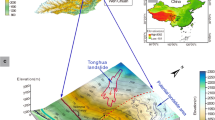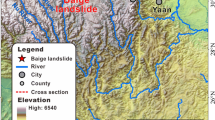Abstract
This paper provides newly found and profound insight into the initiation mechanism of the first Baige landslide occurred on the upper reaches of the Jinsha River in October 10, 2018. The detailed geological characteristics are interpreted by comprehensive field surveys in the past year, which indicate that the Baige landslide developed in the Jinsha River tectonic suture zone, and the active tectogenesis significantly contributes to broken stratigraphic structures and complex spatial distribution of lithologies. The initiation is considered to be long-term creep under the exogenic and endogenic integration, while the active tectogenesis and the influence of serpentinite and foliation, respectively, are the primary exogenic and endogenic factors. In addition, this creep process can be analyzed within three stages: evolution and formation of failure-prone geological structures, progressive deformation and fracturing, and shear failure of the locking section. The distribution and easily degraded behavior of the serpentinite are the fundamental, enabling the formation of failure-prone structures and also responsible for the subsequent deformation evolution. The foliation controls the toppling deformation-failure mode and direction. Furthermore, this catastrophic landslide further reminds us to pay attention to the landslides along the upper reaches of the Jinsha River, and our preliminary results indicate that the distribution characteristics of landslides significantly depend on the Jinsha River tectonic suture zone and the serpentinite mélange belt and thus are always associated with tectonically induced damage.










Similar content being viewed by others
References
Barton N (2007) Rock quality, seismic velocity, attenuation and anisotropy. Taylor & Francis, London
Brideau MA, Yan M, Stead D (2019) The role of tectonic damage and brittle rock fracture in the development of large rock slope failures. Geomorphology 10:30–49
Cui P, Zhu YY, Han YS, Chen XQ, Zhuang JQ (2009) The 12 May 2008 Wenchuan earthquake-induced landslide lakes: distribution and preliminary risk evaluation. Landslides 6:209–223
Dai FC, Lee CF, Deng JH, Tham LG (2005) The 1786 earthquake-triggered landslide dam and subsequent dam-break flood on the Dadu River, southwestern China. Geomorphology 65:205–221
Deere DU, Hendron AJ, Patton FD, Cording EJ (1967) Design of surface and near-surface construction. In The 8th US symposium on rock mechanics (USRMS). American Rock Mechanics Association, PP 237–302
Deng JH, Lee CF, Ge XR (2001) Characterization of the disturbed zone in a large rock excavation for the Three Gorges Project. Can Geotech J 38:95–106
Dunning SA, Rosser NJ, Petley DN, Massey CR (2006) Formation and failure of the Tsatichhu landslide dam, Bhutan. Landslide 3:107–113
Eberhardt E, Stead D, Coggan JS (2004) Numerical analysis of initiation and progressive failure in natural rock slopes—the 1991 Randa rockslide. Int J Rock Mech Min Sci 41:69–87
Fan XM, Xu Q, Alonso-Rodriguez A, Subramanian SS, Li WL, Zheng G, Dong XJ, Huang RQ (2019) Successive landsliding and damming of the Jinsha River in eastern Tibet, China: prime investigation, early warning, and emergency response. Landslides 16:1003–1020
Ganerød GV, Grøneng G, Rønning JS, Dalsegg E, Elvebakk H, Tønnesen JF, Kveldsvik V, Eiken T, Blikra LH, Braathen A (2008) Geological model of the Åknes rockslide, western Norway. Engineer Geology 102:1–18
Hermanns RL, Blikra LH, Naumann M, Nilsen B, Panthi KK, Stromeyer D, Longva O (2006) Examples of multiple rock-slope collapses from Köfels (Ötz valley, Austria) and western Norway. Eng Geol 83:94–108
Huang RQ, Cheng GQ, Guo F, Zhang GF, Zhang Y (2016) Experimental study on the brittle failure of the locking section in a large-scale rock slide. Landslides 13:583–588
Li HB, Qi SC, Chen H, Liao HM, Cui YF, Zhou JW (2019) Mass movement and formation process analysis of the two sequential landslide dam events in Jinsha River. Landslides:1–12
Mcdougall S, Hungr O (2005) Dynamic modeling of entrainment in rapid landslides. Can Geotech J 42:1437–1448
Ouyang CJ, An HC, Zhou S, Wang ZW, Su PC, Wang DP, Cheng DX, She JX (2019) Insights from the failure and dynamic characteristics of two sequential landslides at Baige village along the Jinsha River, China. Landslides 16:1397–1414
Sassa K, Fukuoka H, Wang FW, Wang GH (2005) Dynamic properties of earthquake-induced large-scale rapid landslides within past landslide masses. Landslides 2:125–134
Sassa K, Nagai O, Solidum R, Yamazaki Y, Ohta H (2010) An integrated model simulating the initiation and motion of earthquake and rain induced rapid landslides and its application to the 2006 Leyte landslide. Landslides 7:219–236
Sichuan Huadi Construction Engineering Co., Ltd (SHCEC) (2013) Investigation on geological disasters after the “8.12” earthquake in Jiangda County, Tibet. Technical report, Chengdu. (in Chinese)
Stead D, Wolter A (2015) A critical review of rock slope failure mechanisms: the importance of structural geology. J Struct Geol 74:1–23
Stead D, Coggan J, Eberhardt E (2004) Realistic simulation of rock slope failure mechanisms: the need to incorporate principles of fracture mechanics. Int J Rock Mech Min Sci 41:563–568
Wang SJ, Li GH, Zhang Q, Lan CL (2000) Engineering geological study of the active tectonic region for hydropower development on the Jinsha River, upstream of the Yangtze River. Acta Geologica Sinica 74:353–361
Xu Q, Zheng G, Li WL, He CY, Dong XJ, Guo C, Feng WK (2018) Study on successive landslide damming events of Jinsha River in Baige Village on Octorber 11 and November 3, 2018. J Eng Geol 26: 1534–1551. (in Chinese)
Yang WT, Wang YQ, Sun S, Wang YJ, Ma C (2019) Using Sentinel-2 time series to detect slope movement before the Jinsha River landslide. Landslides 16:1313–1324
Yin YP (2011) Recent catastrophic landslides and mitigation in China. J Rock Mech Geotech Eng 3:10–18
Yin YP, Wang FW, Sun P (2009) Landslide hazards triggered by the 2008 Wenchuan earthquake, Sichuan, China. Landslides 6:139–152
Yin YP, Sun P, Zhu JL, Yang SY (2011) Research on catastrophic rock avalanche at Guanling, Guizhou, China. Landslides 8:517–525
Zhang M, Yin YP (2013) Dynamics, mobility-controlling factors and transport mechanisms of rapid long-runout rock avalanches in China. Eng Geol 167:37–58
Zhang SL, Zhu ZH, Qi SC, Hu YX, Du Q, Zhou JW (2018) Deformation process and mechanism analyses for a planar sliding in the Mayanpo massive bedding rock slope at the Xiangjiaba Hydropower Station. Landslides 15:2061–2073
Zhang M, Wu LZ, Zhang JC, Li LP (2019) The 2009 Jiweishan rock avalanche, Wulong, China: deposit characteristics and implications for its fragmentation. Landslides 16:893–906
Zhou JW, Cui P, Hao MH (2016) Comprehensive analyses of the initiation and entrainment processes of the 2000 Yigong catastrophic landslide in Tibet, China. Landslides 13:39–54
Ziegler M, Low S, Moore JR (2013) Distribution and inferred age of exfoliation joints in the Aar Granite of the central Swiss Alps and relationship to quaternary landscape evolution. Geomorphology 201:344–362
Acknowledgments
We gratefully acknowledge the support of the National Key R&D Program of China (2018YFC1505404), the project from China Geological Survey (DD20190637), and the National Natural Science Foundation of China (41907225). An editor and two reviewers provided further constructive comments.
Author information
Authors and Affiliations
Corresponding author
Rights and permissions
About this article
Cite this article
Zhang, Sl., Yin, Yp., Hu, Xw. et al. Initiation mechanism of the Baige landslide on the upper reaches of the Jinsha River, China. Landslides 17, 2865–2877 (2020). https://doi.org/10.1007/s10346-020-01495-3
Received:
Accepted:
Published:
Issue Date:
DOI: https://doi.org/10.1007/s10346-020-01495-3




